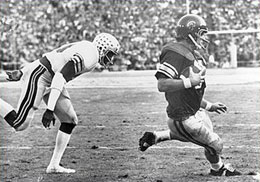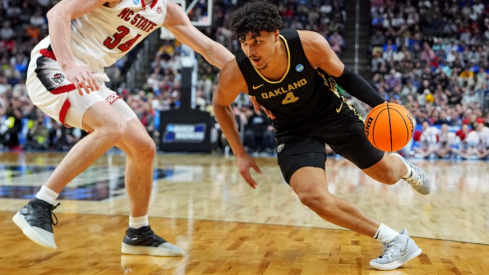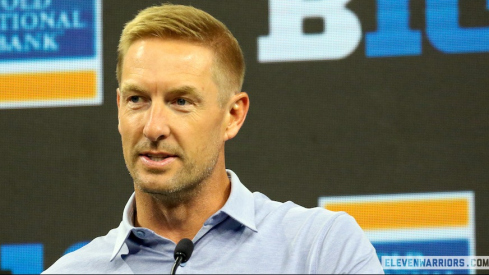
With the emotional rollercoaster that is the status of Beanie Wells taking its toll on Buckeye fans everywhere, we thought we'd throw out a diversion and have asked resident 11W historian Joe Fox to take a look back at a past Ohio State-Southern Cal matchup. Here's his take on the 1975 Rose Bowl.
Ohio State and Southern Cal have frequently met with national title implications on the line, but the 1975 Rose Bowl stands out as one of the two close losses that cost Ohio State a national championship. Let’s roll back the clock to January 1, 1975: Wheel of Fortune made its television debut, the Big Red Machine rolled, the Steelers began their reign of supremacy, and the champions of the Big Ten and Pac-8 met in Pasadena before a crowd of 106,721. Each team harbored hopes for a national title.
Overview
The 1975 Rose Bowl was the third consecutive meeting between Ohio State and USC in Pasadena. The 1973 game was a 42-17 blowout for USC, but Ohio State completely turned the tables in 1974, and crushed the Trojans 42-21. The 1975 meeting would be the rubber match. If Notre Dame could pull off an upset of Alabama in the Orange Bowl, the winner of the 1975 Rose Bowl stood to be in prime position to win at least a share of the national championship.
USC
Coach John McKay’s Trojans were deep, talented and featured a roster with five two-time All-Americans, including eventual three-time All-American and College Hall of Fame linebacker Richard Woods. Senior quarterback Pat Haden directed the offense, but junior running back Anthony Davis was the workhorse, and rushed for 1,421 yards – an impressive tally good enough to earn Davis second place in the Heisman Trophy vote.
The Trojans were expected to be a national title contender in 1974, but started the year with a stunning 22-7 loss to Arkansas. USC then rolled to an 8-0-1 record in their next nine games, including a come-from-behind 55-24 whipping of Notre Dame. The Trojans entered the 1975 Rose Bowl ranked fourth in the country.
Ohio State
Woody Hayes’ Buckeyes came to Pasadena in 1975 for their ninth visit to the Rose Bowl, and fifth appearance against USC. Ohio State had compiled a 10-1 record in 1974, the only loss being a bizarre 16-13 loss to Michigan State in November. The 1974 season ended with a 12-10 victory over Michigan in Columbus, and Ohio State’s third consecutive Big Ten championship.
The Buckeyes’ roster featured 13 players who would be chosen in the 1975 NFL draft, including three first-round selections (defensive back Neal Colzie and offensive linemen Doug France and Kurt Shumacher). Junior running back Archie Griffin ran for 1,695 yards in 1974, sharing backfield duties with Pete Johnson, and became just the second junior to win the Heisman Trophy.
Playing it Close to the Vest
The first half was a defensive slugfest. USC picked up a field goal in the first quarter, but OSU answered with Champ Henson’s two-yard touchdown plunge. Both teams were crippled early by the loss of their offensive stars – Griffin for Ohio State and Davis for USC, who left the game with a rib injury. Ohio State leaned on Pete Johnson and a stifling defense, and went into the fourth quarter clinging to a 7-3 lead.
A Cloudburst of Offense
The Trojans finally broke the scoring impasse with an eight-yard touchdown pass from Hayden to tight end Jim Obradovich that put USC up 10-7. Cornelius Greene engineered the response from Ohio State, and the Buckeyes scored on their next two possessions, taking a 17-10 lead into the final minutes.
McKay vs. Colzie
With only minutes remaining, USC took possession of the ball on its own 17-yard line, and marched to the Ohio State 40, where the Trojans faced a critical fourth-and-one. Alan Carter, filling in for the injured Davis, picked up the drive-sustaining first down, and set up USC with first-and-ten at the Ohio State 38 with just over two minutes remaining in the game, and a critical play call coming up.
“I called the play and I remember both Hayden and Johnny (McKay, the coach’s son) saying, ‘It won’t work,’†coach John McKay remembered. “Johnny said, ‘He (Colzie) is staying way outside. I can never get to the corner on him.’ I said ‘Just try it. See if he gets there.’â€
Regrettably, McKay got to the corner of the end zone, and Colzie didn’t. Haden’s 38-yard touchdown pass with 2:03 left in the game brought USC to 17-16.
In 1967, trailing Purdue by a point in the closing seconds of the game, McKay had elected to try a two-point conversion that failed, and USC lost the Rose Bowl. Now, in 1975, McKay didn’t hesitate. He and offensive coordinator John Robinson (who went on to coach USC in two separate stints) called a roll-out to the right, giving Hayden the choice of running with the ball or finding Johnny McKay in the end zone for the win.
On the two-point conversion attempt, Haden indeed rolled right, but found neither running room nor his friend Johnny McKay open. He elected to go with a jump-pass to Sheldon Diggs, who made a diving catch that gave USC the 18-17 lead.
Ohio State had a last chance to retake the lead, but a desperation 62-yard field goal attempt by Tom Skladany fell short, and USC had its second victory since 1972 over Ohio State in the Rose Bowl.
The Aftermath
Notre Dame pulled off a startling upset of Bear Bryant’s heavily-favored Crimson Tide, and that propelled USC to a shared national title (Oklahoma won the AP vote, USC the UPI tally). John McKay ended his career at USC, compiling a 5-3 record in the Rose Bowl; Ohio State finished the year 10-2, and ranked third nationally by the UPI.
“Even today, almost 25 years later, when January 1 rolls around, I think about that game,†Pat Haden said in 1999. “All of us who played in it have a connection with that game and that moment.â€

